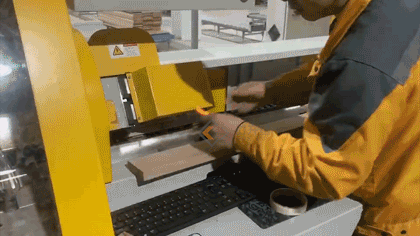1. What is a sawing machine
The servo position control module of the sawing machine system adopts position control combined with sampling interpolation and predictive power to decide the position of closing the feeding cylinder so that the feeding cylinder reaches the target position when it stops. Due to electromagnetic mechanical lag and motion inertia, it is almost impossible to control the feeding slide movement 0.1mm by “through” and “off.” The rear clamp retracts the feed slide to the LK position and then moves forward to the predicted position LT to close the feed solenoid to ensure minimum feeding length and accuracy. The rear clamp is clamped when the feeding cylinder stops moving.
2. Classification of sawing machine
1) Circular sawing machine
Circular sawing machines, also known as circular saws, are divided into fully automatic and semi-automatic. The circular saw blade acts as a rotating cutting motion while feeding motion with the saw blade box. Circular sawing machines are divided into three types according to the blade feed direction: horizontal (horizontal feed), vertical (vertical feed) and pendulum (swing feed around a point).
There are also a variety of special circular sawing machines, such as shaking head saws for cutting castings of large castings and combined saw-drill machines for rail sawing and drilling.
2) Band sawing machine
The annular saw band is tensioned on two saw wheels, and the saw wheel drives the saw belt to cut. There are two main types of band sawing machines: vertical and horizontal.
The saw frame of the vertical band sawing machine is set vertically, and the workpiece moves during cutting to cut the curved contours of sheets and formed parts. The saw belt can also be replaced with a file chain or abrasive belt for filing or sanding.
The saw frame of a horizontal band sawing machine is arranged horizontally or inclined, feeding vertically or in the direction of swinging around a point. The saw band is generally twisted 40° to keep the saw tooth perpendicular to the workpiece.
Horizontal type is divided into scissor-type, double column and single column band sawing machine; according to the usage situation, it is divided into manual type (economical manual feeding, manual cutting material) and automatic type; according to the automation program using the controller, it can be divided into manual type (semi-automatic manual feeding) fully automatic type (automatic feeding and automatic cutting)
3)Hacksaw
The saw bow equipped with a saw blade makes a reciprocating motion and feeds in a way that the saw frame swings around a point. There are two motion trajectories for hacksaw blades: straight lines and arcs.
When the arc moves, the saw bow swings around a point at a slight angle, and the cutting amount of each sawtooth is large, chip removal is easy, and the efficiency is high.

3. sawing machine mechanical structure
The main components of the sawing machine are base seat, bed, column; saw beam and transmission mechanism; guide device, workpiece clamping; tensioning device; feeding frame; hydraulic transmission system; electrical control system; lubrication and cooling system.
1)Base
The base is a box-shaped structure welded by steel plate, the bed and column are fixed on it, the inner cavity of the base has ample space, the front left is an electric button control box, the right side is an electrical distribution board box, the middle is a steel plate welded hydraulic oil tank, the cavity is equipped with a hydraulic pump station, a hydraulic pipeline, and the right side is a cooling cutting fluid tank and a water pump.
2)Bed
The bed is cast iron, fixed on the base, and the column is composed of a large and small cylinder, which serves as a guide rail for the saw frame movement, is used to support the lifting action of the saw beam up and down, and ensure accurate guidance, and the small cylinder plays an auxiliary role, to ensure the regular cutting of the saw blade. The clamping device on the left is that the clamping screw passes through the inner hole of the hydraulic clamping cylinder rod and turns the handwheel or pressing the button to make the left jaw move left and right.
3)Applicable occasions
mainly used for unloading machinery, forging, processing, etc.
4)Functions and features
hydraulic control sawing speed, stepless adjustable. Cylinder control, feed smoothly. Bundling devices can be added according to customer needs. Semi-automatic and CNC fully automatic are available as required. It can be used for angle mitre sawing.
5)Working principle of ShikaNIU sawing machine
The hydraulic transmission system consists of a hydraulic circuit composed of pumps, valves, cylinders, oil tanks, pipelines and other components.
Through the speed control valve, the feed speed can be adjusted stepless to meet the sawing needs of different materials of workpieces. The electrical control system consists of a control circuit composed of an electric box, a control box, a junction box, a stroke switch, an electromagnet, etc., which is used to control the rotation of the saw blade, the lifting of the saw beam, the clamping of the workpiece, etc.
6)Product type
There are hinged type, single-column type, double column type—gantry type and vertical type, divided into semi-automatic and CNC fully automatic.
4. Installation and commissioning of sawing machine
1. The hydraulic oil on the sawing machine should be added enough, and a layer of lubricant should be applied to the sliding and rotating parts.
2. The band saw machine is equipped with a saw belt, adjust the tensioning device (turn the left handle of the saw frame) to tighten the saw belt to a suitable degree, and at the same time adjust the stroke switch contact touches the stop iron and is in the open state.
3. Add enough cooling liquid to the cooling water tank.
4. After the above preparations are made, connect the power supply, the grounding must be standard and reliable, turn on the power switch (on the electrical control box), start the saw test, follow the rotation correction wiring indicated on the sign, and listen to whether the sound is typical.
During operation, the saw bow is automatically lowered. The saw band falls 0.5~1mm below the worktable, and the limit switch head automatically rises when it hits the collision block.
During operation, the adjusting tensioning device is in a relaxed state so that the stroke switch contacts leave the bumping block and turn off the power, and experiment three times in a row.
5. Check the lifting and lowering cylinder devices, check whether the saw bow lifts and falls, whether it is reliable and flexible.
6. Check the clamping and loosening cylinder device, check whether the clamping is reliable during clamping and whether the loosening is flexible.
7. Adjust the speed control knob to 1 (low speed) operation, then adjust the speed to 2 (high speed) operation, and repeat the experiment three times.
8. After the main motor power switch is turned on, the water pump starts simultaneously, and the cooling system usually runs. Debug the valve and check if the coolant is smooth.
9. After the above preparations are made, the loading is clamped and locked for trial sawing.


